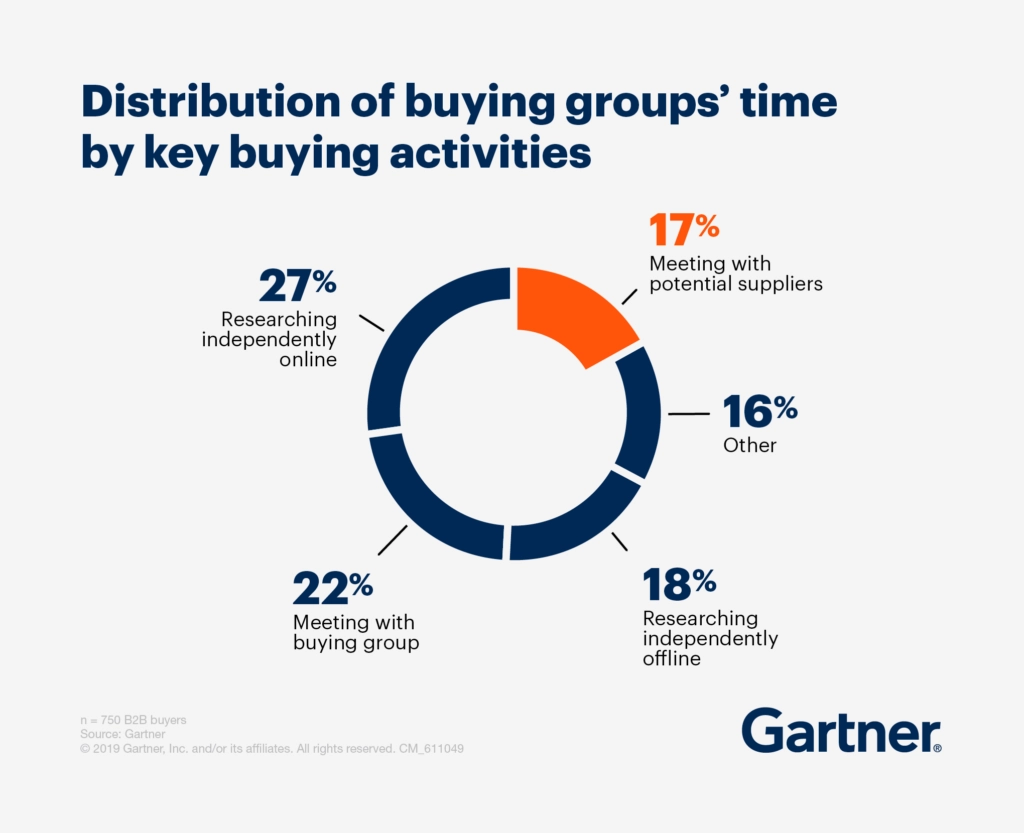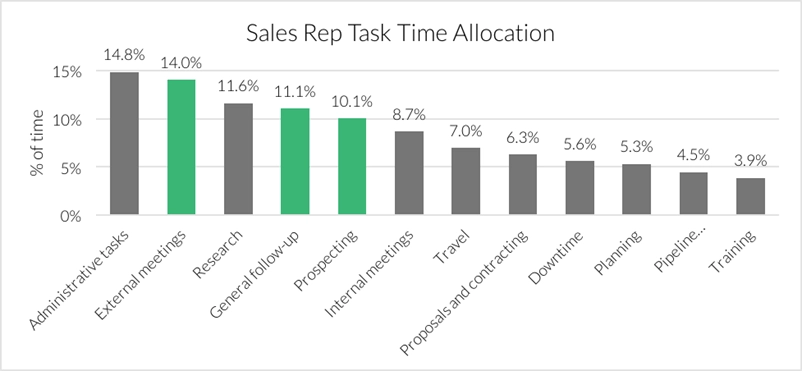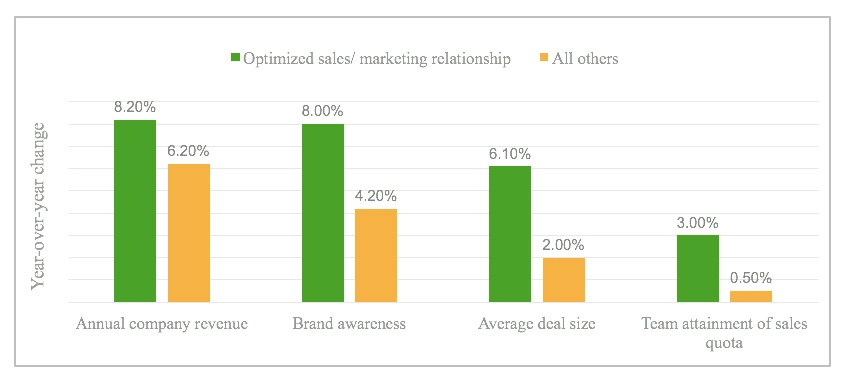
Introduction
B2B buying habits are increasingly changing.
Sales and marketing strategies that worked a decade ago are no longer relevant in the current environment. Current trends show profound changes in B2B buying behavior and expectations.
In today’s business world, B2B buyers exhibit characteristics of both B2C and B2B buyers. Rather than being loyal and rational, B2B buyers are increasingly becoming unpredictable and emotional.
This is largely due to increased access to industry knowledge, product information and intelligence about competition. In fact, statistics show that on average, modern-day B2B buyers conduct 12 online searches prior to interacting with the website of a potential vendor. The opportunity to conduct online research makes them susceptible to the influence of external opinions as well as recommendations and reviews left by other customers.
But this is not all. The ability of modern day B2B buyers to conduct vast research by themselves means that they start engaging sales teams much later in the purchase journey. Available data shows that by the time a B2B buyer decides to talk to a sales representative, he is already 57% through the purchase journey.
The amount of time that B2B buyers spend interacting with potential buyers is also shrinking. A study by Gartner also shows that B2B buyers only spend 17% of their purchase journey time meeting prospective suppliers.

The fact that multiple decision makers are involved in the buying process complicates issues further. This means the B2B buying journey is not a straight path. Rather, for 90% of such buyers, the purchase journey is filled with twists and turns that leave sales reps with little time and a lot of pressure to:
- Understand the unique challenges of the buyers and solve them
- Shift the perception of buyers to align with their product’s value proposition
- Close deal with the buyer
These changes reflect the future of B2B buying. To survive, B2B sales teams have to adjust their buyer engagement strategies in order to strengthen customer relations and increase sales.
So, how can companies address the needs of the modern day B2B buyers?
Top 4 Strategies to Prepare For the Future of B2B Buying:
- Make the Sales Function More Efficient
- Give Buyers an Interactive Buying Experiences
- Align Your Sales and Marketing Functions
- Embrace Dynamic Selling
1. Make the Sales Function More Efficient
B2B buyers are complex, and their buying journey is much longer than that of B2C buyers.
To sell to these buyers effectively, B2B companies must find innovative ways to improve efficiency in their sales functions.
In a typical B2B company, sales reps spend less time selling than they do on administrative tasks. A quick look at statistics shows that 64% of sales rep’s time is spent on activities that do not generate revenue and only 36% on actual selling. Understanding how your sales team spends their time is the first step towards making them more efficient.
The image below shows the activities that sales reps engage in and the average time they spend on each activity.

Source: TextRequest
Rather than spending a lot of time on non-revenue generating activities, sales reps should be engaging in:
A. Buyer Persona Creation
Sales reps waste up to half of their working time on unsuccessful prospecting. Activities such as searching for leads on LinkedIn takes plenty of their time each week.
You can reduce this time by either outsourcing lead searches to third parties or automating lead prospecting using machine learning tools.
Before you do this, you’ll have to invest time creating solid buyer personas. Though they take time to create, buyer personas enable companies to get more high quality leads that are easier to convert.
B. Lead Scoring
Following up on prospects is a routine task that consumes a considerable amount of time in a sales rep’s day. It is an important task considering that 80% of deals are closed between the fifth and twelfth follow-up meeting.
However, B2B companies can sell more if sales reps invest time in lead scoring in order to prioritize prospects that need to follow up. This enables them to score each prospect depending on their behavior and engagement with their brands.
C. Follow-up on Existing Customers
Selling to existing customers is easier, and even cheaper than selling to new customers. In fact, statistics show that it costs up to five times more to get new customers than to retain current ones. Sales teams therefore need to follow-up on existing customers, not just for repeat purchases, but also for referrals.
While this may be a challenging task to pull off, sales teams that invest time connecting with existing customers can identify upselling and cross selling opportunities for the company.
D. Monitoring Lead Activity on Company Websites
When you call a lead five minutes or less after they submit an online form, there is 100% chance of getting them on the phone. This means that sales reps should spend more time tracking website activities in order to find such high quality leads. The best way is to use lead tracking tools or creating CRM workflows that allow them to get new lead notifications.
B2B companies can also enhance sales efficiency by creating centralized information repository facilities like knowledge bases to enable sales reps access updated information with ease. This cuts down on the time they spend searching for materials.
2. Give Buyers an Interactive Buying Experiences
Modern-day B2B buyers are constantly distracted during one-on-one interactions.
Emails, phone calls, social media notifications and other digital communication tools keep them engaged throughout the day.
While this is good because it enhances their efficiency at work, it is a behavior that makes it difficult for B2B sales teams to keep prospects interested throughout the sales meetings. This requires B2B sellers to find creative ways of making buying experiences interactive.
An effective way to do this is to leverage interactive tools like ROI calculators. B2B sellers can also integrate guided selling methods that require prospects to take action or make inputs. These techniques can go a long way in keeping B2B buyers interested in their offerings.
As they see things unfold based on their interaction with product or service offerings, buyers begin to trust the sellers more. The reality is that buyers are looking for more interactions from sales teams.
B2B sellers need to maximize this opportunity and show their sellers new stuff about their business, the industry they are in or the market using engaging presentations and meetings.
3. Align Your Sales and Marketing Functions
Both sales and marketing functions play an important role in the selling process.
B2B buyers spend a significant amount of time searching the internet. As such, B2B companies should ensure that their content marketing efforts empower buyers to make favorable decisions every step of the purchase journey.
This is where alignment of sales and marketing functions, particularly in content development, comes in. Since they interact with customers regularly, sales reps understand their needs better. Marketers need to utilize this understanding in order to create and distribute content that is relevant and helpful to prospects.
Misaligned marketing and sales functions are costly to the business – statistics show that companies lose 10% or more of their annual revenue each year when the two departments are misaligned.
Whether your company creates videos, blogs, white papers, or social media posts, ensuring that the content resonates with customer needs. This makes it easy to attract and nurture quality leads down the sales funnel.
It also yields positive results as evidenced by 56% of companies that attribute their success in achieving revenue goals to well aligned sales and marketing teams.

Source: SuperOffice
4. Embrace Dynamic Selling
A report by Forrester shows that 59% of B2B buyers prefer to search the internet than talk to a sales rep.
Why? Sales reps push the sales agenda as opposed to helping them solve their problem. Their focus is on selling – not supporting prospects through their purchase journey.
That’s why with the changing B2B buyer behavior and expectations, B2B sellers need to adopt the dynamic selling approach. In dynamic selling, companies align their selling plans to their customer’s purchase process.
Each customer, or group of customers follows a unique decision making and buying process. To meet the needs of individual customers, companies should make their selling processes flexible. This means investing time in understanding how their customers make purchase decisions and building relationships with them.
Since no single process will fill all customers, dynamic selling offers B2B companies the advantage of diagnosing customer issues, scaling their teams and projecting their future needs more accurately. To succeed in dynamic selling, you need to:
- Know how your target customers identify buyers
- Place the customer at the center of the selling process
- Align your selling process with the customer’s decision making process
- Use collaborative tools to empower customers about your products and processes
- Break deal closing into stages
- Follow your leads through at every stage of the selling process
- Customize a dynamic selling process for each potential deal
Bottom Line
It is not in doubt that B2B buyers have changed their expectations and purchase behavior. The modern day B2B buyer is more empowered and tech savvy than the buyer of yester-years. To boost sales in future, B2B companies must also change the way they engage prospects throughout the selling process.
They must be prepared to remove barriers that hinder efficiency in the sales process and give buyers experiences that keep them hooked to their offerings. To meet the dynamic needs of the modern day buyer, B2B companies should not only create alignment between sales and marketing teams, but they also need to align their selling plan to their customer’s purchase process.
Related Read: The Ultimate B2B Lead Generation Buying Guide
Our blog
Latest blog posts
Tool and strategies modern teams need to help their companies grow.

Beat your competitors and exceed your revenue goals this year by shifting your focus ...

SaaS growth has never been more challenging. SaaS companies must move faster and smar...

In the absence of a solid lead scoring system, your sales team will spend time pursui...




